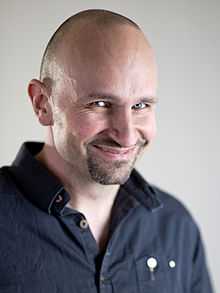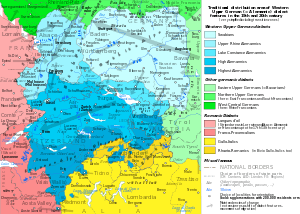Swabian German
| Swabian | |
|---|---|
| Schwäbisch[1] | |
| Native to | Germany[1] |
Native speakers | 820,000 (2006)[2] |
|
Indo-European
| |
| Latin (German alphabet) | |
| Language codes | |
| ISO 639-3 |
swg |
| Glottolog |
swab1242[3] |
|
Areas where Alemannic dialects are spoken Swabian | |
Swabian (![]() Schwäbisch ) is one of the Alemannic dialects of High German. It is spoken in Swabia, a region which covers much of Germany's southwestern state Baden-Württemberg, including its capital Stuttgart, as well as the rural area known as the Swabian Alb, and parts of southwestern Bavaria (Bavarian Swabia). Swabian is also spoken by part of the Danube Swabian minorities in Hungary, former Yugoslavia, Romania, and the former Soviet Union.
Schwäbisch ) is one of the Alemannic dialects of High German. It is spoken in Swabia, a region which covers much of Germany's southwestern state Baden-Württemberg, including its capital Stuttgart, as well as the rural area known as the Swabian Alb, and parts of southwestern Bavaria (Bavarian Swabia). Swabian is also spoken by part of the Danube Swabian minorities in Hungary, former Yugoslavia, Romania, and the former Soviet Union.
Description and character
The dialect ranges from a 'standard' Swabian, spoken in Stuttgart, to a variety of stronger, thicker forms found in the countryside. Older people can often tell the town a person comes from merely by hearing their accent.
Swabian is difficult to understand for speakers of Standard German, not just for its pronunciation but because it contains some vocabulary that differs altogether from Standard German. For example, strawberry jam in Standard German is Erdbeermarmelade while in Swabian it is Bräschdlingsgsälz.[4]
In 2009, Muggeseggele (a Swabian idiom), literally referring to the scrotum of a male housefly, was elected in a readers survey by Stuttgarter Nachrichten, the largest newspaper in Stuttgart as the most beautiful Swabian word, with a large lead on any other expression.[4] The expression is being used as an ironic small measurement unit and is deemed usable towards children (compare Bubenspitzle). German public broadcaster SWR's children's website Kindernetz explained Muggeseggele in their Swabian dictionary for the TV series Ein Fall für B.A.R.Z., which takes place in Fellbach. The website use the sentence A muggeseggele Zeit hetta miar no! and translates it as Ein bisschen Zeit hätten wir noch, meaning we still have a tiny bit of time left.[5]
Linguistic
Some characteristics in comparison to Standard German:
- The ending "-at" is used for verbs in the first person plural. (For example, "we go" is mir gangat instead of Standard German's wir gehen.)
- As in other Alemannic dialects, the pronunciation of "s" before "t" and "p" is [ʃ] (For example, Fest ("party"), is pronounced as Fescht.)
- There are also a few other sound shifts. All plosives are pronounced in a voiced fashion, removing the distinction between the consonants 'b' and 'p' as well as 'd' and 't', which is made in Standard German. In technical terms, the voice onset time is about halfway between where we would expect it for a clear contrast between voiced and unvoiced-aspirated stops. To the layperson, this difference is most noticeable on the unvoiced stops, rendering them extremely similar to or indistinguishable from voiced stops. For example:
"t" to "d" Tasche (bag) becomes Dasch' Tag (day) becomes Dag
"p" to "b" putzen (to clean) becomes butza Papa (dad) becomes Baba
- One simple thing to look for is the addition of the diminutive "-le" suffix on many words in the German language. With the addition of this "-le" (pronounced /lə/), the article of the noun automatically becomes "das" in the German language, as in Standard German. The Swabian "-le" is the same as standard German "-lein" or "-chen", but is used, arguably, more often in Swabian. A small house (German: Haus) is a Häuschen in Standard German, a Heisle in Swabian.
Zug (train) becomes Zigle Haus (house) becomes Heisle Kerl (guy) becomes Kerle Mädchen (girl) becomes Mädle Baum (tree) becomes Baimle In some regions "-la" for plural is used. (For example, Heisle may become Heisla, Spätzle becomes Spätzla.) Many surnames in Swabia are also made to end in "-le".
- Articles (der, die and das) are often pronounced as "dr", "d" and "s". ( "s Haus" instead of "das Haus")
- The "ch" is sometimes omitted or replaced.
"ich" becomes i "dich" becomes di "mich" becomes mi
- Vowels:
| German | Swabian | Example (German = Swabian) |
|---|---|---|
| short a [a] | [a] | machen = macha |
| long a [aː] | [oː] | Schlafen = Schlofa |
| short e [ɛ] | [e] | Mensch = Mentsch |
| [ɛ] | Fest = Fäscht | |
| long e [eː] | [ɛa̯] | Leben = Läaba |
| short o [ɔ] | [ɔ] | Kopf = Kopf |
| long o [oː] | [aʊ̯] | hoch, schon = hau, schau |
| short ö [œ] | [e] | können, Köpfe = kena, Kepf |
| long ö [øː] | [eː] | schön = sche |
| short i [ɪ] | [e] | in = en |
| long i (ie) [iː] | [ia̯] | Nie = Nia |
| short ü [ʏ] | [ɪ] | über = iber |
| long ü [yː] | [ia̯] | Müde = Miad |
| short u [ʊ] | [ɔ] | und = ond |
| long u [uː] | [ua̯] | Gut = Guat |
| ei [aɪ̯] | [ɔa̯], [ɔɪ̯][6] | Stein = Stoa/Stoi |
| [ei̯][7] | mein = mei | |
| au [aʊ̯] | [ou̯] | haus = hous |
| eu [ɔʏ̯] | [ei̯], [ui̯] | feuer = feijer/fuijer |
In many regions the Swabian dialect is spoken with a unique intonation that is also present when Swabian native speakers talk in Standard German.
The voiced plosives, the post-alveolar fricative, and the frequent use of diminutives based on "l" suffixes gives the dialect a very "soft" or "mild" feel, that is often felt to be in sharp contrast to the harder varieties of German spoken in the North.
Classification and variation
Swabian is categorized as an Alemannic dialect, which in turn is one of the two types of Upper German dialects (the other being Bavarian). The ISO 639-3 language code for Swabian is swg.[8]

The Swabian dialect is composed of numerous sub-dialects, each of which has its own variations. These sub-dialects can be categorized by the difference in the formation of the past participle of 'sein' (to be) into gwäa and gsei. The Gsei group is nearer to other Alemannic dialects, such as Swiss German. It can be divided into South-East Swabian, West Swabian and Central Swabian.[9]
Recognition in mass media

The Baden-Württemberg Chamber of Commerce was highly praised for its advertising campaign with the slogan "Wir können alles. Außer Hochdeutsch." which means "We can [do] everything. Except [speak] Standard German." The campaign was clever in boosting Swabian pride for their dialect and industrial achievements.[10] It however failed to impress Northern Germans[11] and neighboring Baden. Dominik Kuhn (Dodokay) became famous in Germany with schwäbisch fandub videos, dubbing among others Barack Obama with German dialect vocals and revised text.[12]
Swabian dialect writers
- Sebastian Sailer (1714–1777)
- August Lämmle (de) (1876-1962)
- Josef Eberle (as Sebastian Blau) (de) (1901-1986)
- Thaddäus Troll (1914–1980)
- Hellmut G. Haasis (born 1942)
- Peter Schlack (de) (born 1943)
Notes and references
- ↑ 1.0 1.1 1.2 Ethnologue entry
- ↑ Swabian at Ethnologue (18th ed., 2015)
- ↑ Nordhoff, Sebastian; Hammarström, Harald; Forkel, Robert; Haspelmath, Martin, eds. (2013). "Swabian". Glottolog. Leipzig: Max Planck Institute for Evolutionary Anthropology.
- ↑ 4.0 4.1 Schönstes schwäbisches Wort, Großer Vorsprung für Schwabens kleinste Einheit, Jan Sellner 09.03.2009, Stuttgarter Nachrichten
- ↑ Swabian dictionary at website of Südwestrundfunk Ein Fall für B.A.R.Z.
- ↑ From MHG [ei̯]
- ↑ From MHG [iː]
- ↑ Code for Swabian German (swg)
- ↑ Noble, Cecil A. M. (1983). Modern German dialects New York [u.a.], Lang, p. 63.
- ↑ Baden-Württemberg Chamber of Commerce
- ↑ Diskriminiteer Dialekt Armes Süddeutsch FAZ 2013
- ↑ Star Wars dub sends jobbing ad man into orbit, By Dave Graham Reuters STUTTGART, Germany Thu Oct 14, 2010
External links
| For a list of words relating to Swabian language, see the Swabian language category of words in Wiktionary, the free dictionary. |
| ||||||||||||||||||||||||||||||||||||||||
